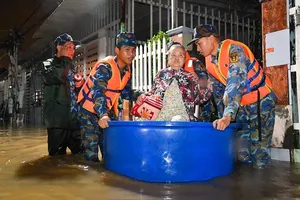To minimize losses, many households are compelled to harvest their produce early and sell it quickly to traders.
On the morning of November 5, in the Lo Sau area of Xuan Dai Ward, Dak Lak Province, dozens of trucks from traders across the region arrived to purchase lobsters. At the pier, numerous boats, ships, and speedboats were constantly ferrying lobsters to the traders. Tens of tons of lobsters had sold by the end of the morning.
Local lobster farmers claim that prices have fallen precipitously as a result of the haste to sell before the storm. Some traders have even forced prices down. Live lobsters are being sold for VND770,000 (US$29.3)–VND780,000 (US$29.7) per kilogram, while dead lobsters fetch only VND520,000 (US$19.8) per kilogram.


Currently, Xuan Dai Bay has hundreds of thousands of cages and ponds for raising seafood, primarily lobsters, concentrated in Xuan Dai and Song Cau wards, with around 100,000 cages. Ahead of typhoon Kalmaegi, it is estimated that tens of millions of lobsters are being farmed in the area.
Not only lobster farmers but also households raising cage-farmed fish near the shore are rushing to harvest their stock.
On November 5, border guards, police, and local militia in Xuan Dai and Song Cau wards stepped up inspections and awareness campaigns, urging fishermen and cage owners to proactively prepare for the storm. Canoes were mobilized to the breeding area to advise residents on safeguarding their property and to be ready for evacuation if the typhoon hits.
Mr. Le Thanh Vu, Vice Chairman of the People’s Committee of Xuan Dai Ward, stated that the locality has over 27,500 lobster cages employing around 1,500 workers. The authorities have issued notices and guidance for residents to secure their cages and harvest early to minimize losses.
By 12:00 p.m. on November 6, all workers in the bay must return to shore; no one is allowed to remain on the cages. After this deadline, the ward will enforce a mandatory evacuation for anyone still on the water, Mr. Vu emphasized.







































